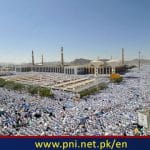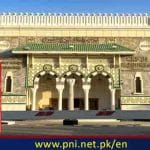Masjid Nimrah is a mosque located in Arafat, Makkah, Saudi Arabia. It is the site where the Prophet Muhammad (PBUH) delivered his last sermon during the Farewell Hajj in 10 AH. The mosque is also where the khutbas are delivered to pilgrims during the Day of Arafah during the Dhuhr and Asr prayers.
The history of Masjid Nimrah dates back to the time of the Prophet Muhammad (PBUH). After reaching Arafat on the 9th of Dhul Hijjah 10 AH, the Prophet (PBUH) camped in the Wadi Uranah, which is where the mosque is located today. After resting for a while, the Prophet (PBUH) got up at midday, sat on his camel, and delivered his last sermon. Following this, he (PBUH) along with 100,000 companions, completed Hajj.
The mosque was originally a small structure, but it was gradually expanded over the centuries. The first major expansion took place in the second century of Islam, when the mosque was rebuilt by the Umayyad caliph, Abdul Malik ibn Marwan. The mosque was further expanded in the third century of Islam, by the Abbasid caliph, Al-Mahdi.
In the 19th century, the mosque was again expanded by the Ottoman Sultan, Abdul Hamid II.
The Saudi government has undertaken several expansions of Masjid Nimrah over the years. The first major expansion was in 1971, when the mosque was enlarged to accommodate 200,000 pilgrims. In 1987, the mosque was expanded again to accommodate 300,000 pilgrims.
In 2010, King Abdullah bin Abdulaziz Al Saud ordered a major expansion of Masjid Nimrah. The expansion project was completed in 2012, and it increased the capacity of the mosque to 600,000 pilgrims. The expansion project also included the construction of a new ablution facility and a new parking lot.
In 2015, King Salman bin Abdulaziz Al Saud ordered another expansion of Masjid Nimrah. The expansion project is still ongoing, and it is expected to be completed in 2023. The expansion project will increase the capacity of the mosque to 1 million pilgrims.
The expansion of Masjid Nimrah is part of the Saudi government’s efforts to improve the infrastructure of the holy sites in Makkah and Madinah. The government has also undertaken several other projects to improve the facilities for pilgrims, such as the construction of new hotels and transportation systems.
Masjid Nimrah is one of the most important mosques in Islam. It is a site of great historical significance, and it is also a place where millions of Muslims gather each year to perform Hajj.
The mosque is named after the mountain, Jabal Nimrah, which is located nearby.








